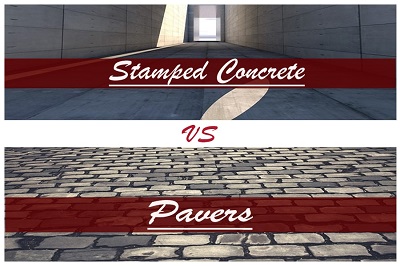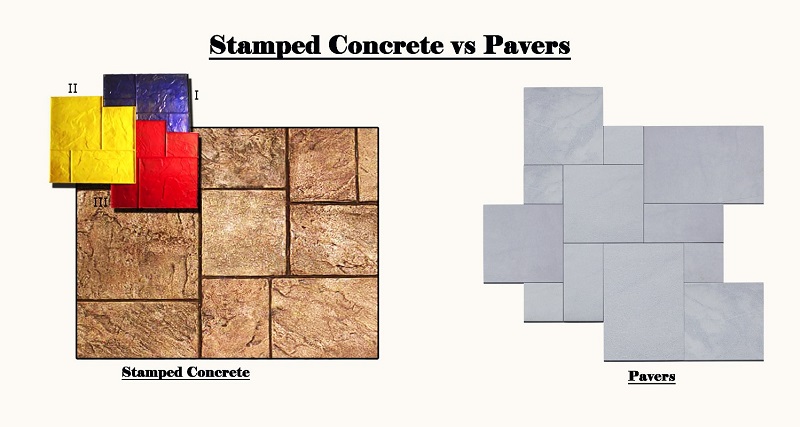by Linea Lorenzo
There are two ways to create flooring for your home’s patios, sidewalks, driveways, and pool decks.
The first of these is to apply stamped concrete.
The second of these is to apply pavers.
Both of these methods seek to accomplish the same goal, which is to provide solid flooring for the outdoor portions of your home.
Many mistakenly believe that the differences between these two are negligible at best, but that could not be further from the truth.
Although stamped concrete and pavers accomplish the same goal for the outdoor portions of your home, they follow completely different processes of providing flooring for the outdoor portions of your home.
If you are even remotely interested in optimizing your exterior home flooring, you would do well to explore and analyze the differences between stamped concrete and pavers.
Before familiarizing yourself with these differences, it helps to understand why you might need some sort of pavement installed around the exterior of your home.
Contents

What is the one chore that almost everybody dreads to where they will gladly pay anybody from adolescents to grown adults to do for them?
Mowing the lawn, that’s what.
If your home’s exterior does not contain stamped concrete or pavers, you should prepare to cut a lot more lawn around your home’s exterior than you might want.
That is one reason why you might want to utilize stamped concrete or pavers, especially for your driveway.
If you leave your driveway bare, it might damage the automobiles that enter said driveway, since most bare driveways contain gravel and other things that could possibly damage a car’s tires.
If you have children who want to play in the driveway, you will definitely want to pave the driveway. This will make it much easier and safer for them to play compared to a bare driveway.
Another reason why some kind of pavement might be necessary for the exterior parts of your home is because it carries much more aesthetic value compared to if these areas are bare.
Think back to the last home you visited where everything on the exterior was bare. Did you not think that the total exterior design of the home looked unfinished?
That is because it is unfinished. Bare driveways are not pleasant to look at, impress nobody, and are not really safe to drive on or to walk on.
This is true for other certain exterior portions of your home as well, such as patios. What does a “bare” patio look like? In most cases, it is nothing more than a completely bare backyard that maybe contains a gazebo or something like it.
Even though it will cost you, inserting some kind of pavement on the exterior of your home is a very good idea.
What kind of pavement you should install is the major question here, and it is why the differences between stamped concrete and pavers need to be explored and analyzed.

Think of concrete and pavement as nothing more than a form of flooring, but flooring that is generally installed on the outside of your home and not the inside.
Stamped concrete does this by utilizing concrete as a base as well as an accent. Colors of your choice are then selected as a part of this base and accent as a pattern, and then the pattern is “stamped” onto the concrete base.
When finished, you will achieve a look that resembles natural stone, slate, and brick patterns that will last a long time.
There are a few things that you need to be aware of if you have chosen stamped concrete as a form of pavement for the exterior of your home.
First, it resembles stone, slate, and brick patterns but they are not perfectly true to these patterns. Because of this, you might experience inconsistencies in the patterns since they are stamped.
Stamped concrete also absorbs a lot more heat than you might want it to absorb because of its concrete base. This can make walking on it very unpleasant, especially when in hotter climates.
However, getting stamped concrete installed is very cost-effective and if you have a limited budget, you should consider it.
Different than stamped concrete which utilizes concrete as a base and stamps stone, slate, or brick patterns, pavers combine the stone, slate, and brick patterns into pavement.
This not only provides a much more natural look, it also opens up an entire world of different designs for patterns that are just not possible with stamped concrete.
Pavers are perfect for patios because of the vast amount of designs that you can choose from. And because they will not absorb as much heat as stamped concrete, pavers are also ideal for driveways.
In terms of overall quality, pavers contain a lot more value than stamped concrete, but there are two things that you need to be aware of with pavers.
First, do not forget that you have a lot of different designs to choose from. This can get very overwhelming, especially if you are looking for simplicity. Simplicity is something you should not expect from pavers, and in order to choose the right kind of pavestone, you will need to know exactly what kind of style you want for your home. Otherwise, you will get lost in the many available designs and styles.
Something else that you certainly need to watch for when it comes to pavers is how they will affect your budget. Pavers are much more expensive to put in than stamped concrete, and they take much longer to install as well. If you have decided on pavers, you will need a budget that will cover all of the costs.
On the surface, there is not much of a difference between stamped concrete and pavers.
In fact, they both accomplish the very same thing: Building pavestone over the bare grass and gravel in the exterior of your home.
Even though they accomplish the very same thing, stamped concrete and pavers differ significantly in a few major areas.
The first of these is aesthetics. Because stone, slate, and brick patterns are stamped in stamped concrete, you will be limited in their designs. Pavers have a lot more to offer when it comes to designs, and they are clearly the better choice.
Price is also something where stamped concrete are much different than pavers. Because the stone, slate, and brick pavestone is not stamped into concrete with pavers, you get a lot more value from it. This means that cost a lot more than their stamped concrete counterparts.
If you have a vast budget to work with and know exactly what kind of design of pavestone you want for your home, pavers are clearly the better choice. They will look really impressive and you cannot go wrong with natural pavestone.
However, stamped concrete can be a practical alternative if you do not have the budget for pavers. You will need to sacrifice a couple of conveniences for stamped concrete, but they are negligible. First, because the pavestone is based in concrete, stamped concrete can get hot in warmer climates. While they do not become unbearably hot, this can still be a nuisance.
Second, do not forget that you will not have the draw of designs you enjoy with pavers when it comes to stamped concrete.
Now that you have familiarized yourself with stamped concrete and pavers, you should be able to make a better decision about which one you would like installed as a pavestone for your home.
 |
 |
 |
 |

About Linea Lorenzo
Linea was born to love drawing and just a few tech gadgets. While not working or sleeping, he often spends hours to look through the coolest, latest gadgets at different shopping sites, drooling about them. He also likes to keep things clean and tidy - now that the reason you see so many cleaning devices and electronics reviews at linea.io. Ah yes, he made the site also just for that. Occationally, he invited friends to share their expertise around here too. Linea received Bachelor of Arts in Arts & Letters at Sacramento State University.
 |
 |
 |
 |
You can Get FREE Gifts. Furthermore, Free Items here. Disable Ad Blocker to receive them all.
Once done, hit anything below
 |
 |
 |
 |